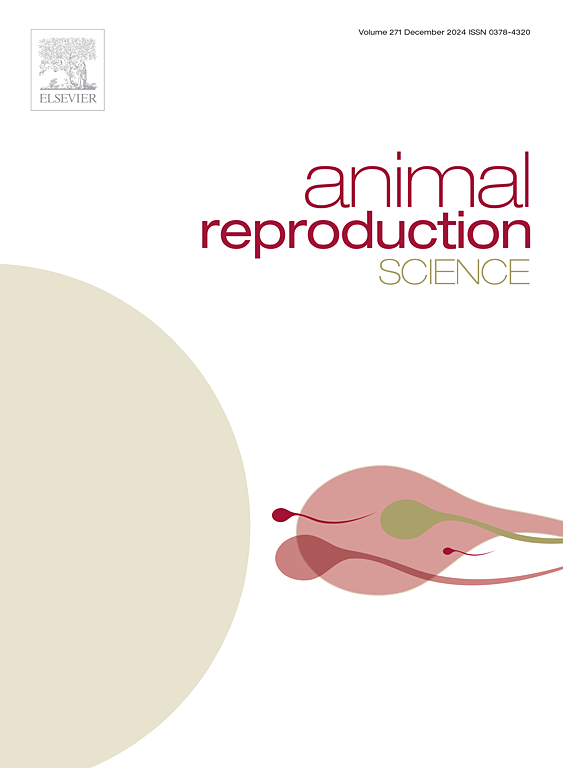牛雄性生殖道中的水通道蛋白:从小牛到繁殖公牛
IF 3.3
2区 农林科学
Q1 AGRICULTURE, DAIRY & ANIMAL SCIENCE
引用次数: 0
摘要
水通道蛋白(AQPs)在牛雄性生殖系统中的作用,特别是与精子发生有关的作用,仍然不完全清楚。因此,本研究旨在分析AQP8和AQP11在牛雄性生殖道发育过程中的表达变化。组织样本取自3个年龄组:5-6周龄的小牛(n = 10)、15-25周龄的公牛(n = 10)和2-6周龄的繁殖公牛(n = 11)。采用免疫组化(IHC)方法分析AQPs的表达。在年龄最大的一组动物中,利用PCR验证了AQP8和AQP11在生殖器官特定部位的鉴定。本研究的主要成果包括AQP8在性腺细胞、支持细胞和间质细胞中的定位。AQP8和AQP11分别存在于睾丸网、传出管、附睾连续节段和输精管上皮中,其表达和分布模式随动物生长发育而变化。目前的结果在我们以前的工作观察的背景下得到补充和讨论。结果表明,AQP的表达模式在动物生长发育过程中发生了变化,在性未成熟动物的生殖器官中经常出现弥漫性和异质性的表达模式,而在成熟雄性动物中则转变为明确和一致的表达模式。本文章由计算机程序翻译,如有差异,请以英文原文为准。
Aquaporins in bovine male reproductive tract: From calves to reproductive bulls
The role of aquaporins (AQPs) in the male reproductive system of cattle, particularly in relation to spermatogenesis, remains incompletely understood. Therefore, the aim of this study was to analyze the developmental changes in AQP8 and AQP11 expression in the bovine (Bos taurus) male reproductive tract. Tissue samples were collected from three age groups of animals: calves aged 5–6 weeks (n = 10), young bulls aged 15–25 weeks (n = 10) and reproductive bulls aged 2–6 years (n = 11). The expression of the studied AQPs was analyzed using immunohistochemistry (IHC). The identification of AQP8 and AQP11 in specific sections of the reproductive organs was verified in the oldest group of animals using PCR. The key achievements of this study include the localization of AQP8 in gonocytes, Sertoli cells, and Leydig cells. AQP8 and AQP11 were observed in the epithelium lining the rete testis, efferent ducts, successive segments of the epididymis, and vas deferens, with expression and distribution patterns changing with animal growth and development. The present results were complemented and discussed in the context of observations from our previous works. It was demonstrated that AQP expression patterns change during animal growth and development, with the frequently diffused and heterogeneous location observed in the reproductive organs of sexually immature animals, transitioning to defined and consistent patterns in mature males.
求助全文
通过发布文献求助,成功后即可免费获取论文全文。
去求助
来源期刊

Animal Reproduction Science
农林科学-奶制品与动物科学
CiteScore
4.50
自引率
9.10%
发文量
136
审稿时长
54 days
期刊介绍:
Animal Reproduction Science publishes results from studies relating to reproduction and fertility in animals. This includes both fundamental research and applied studies, including management practices that increase our understanding of the biology and manipulation of reproduction. Manuscripts should go into depth in the mechanisms involved in the research reported, rather than a give a mere description of findings. The focus is on animals that are useful to humans including food- and fibre-producing; companion/recreational; captive; and endangered species including zoo animals, but excluding laboratory animals unless the results of the study provide new information that impacts the basic understanding of the biology or manipulation of reproduction.
The journal''s scope includes the study of reproductive physiology and endocrinology, reproductive cycles, natural and artificial control of reproduction, preservation and use of gametes and embryos, pregnancy and parturition, infertility and sterility, diagnostic and therapeutic techniques.
The Editorial Board of Animal Reproduction Science has decided not to publish papers in which there is an exclusive examination of the in vitro development of oocytes and embryos; however, there will be consideration of papers that include in vitro studies where the source of the oocytes and/or development of the embryos beyond the blastocyst stage is part of the experimental design.
 求助内容:
求助内容: 应助结果提醒方式:
应助结果提醒方式:


